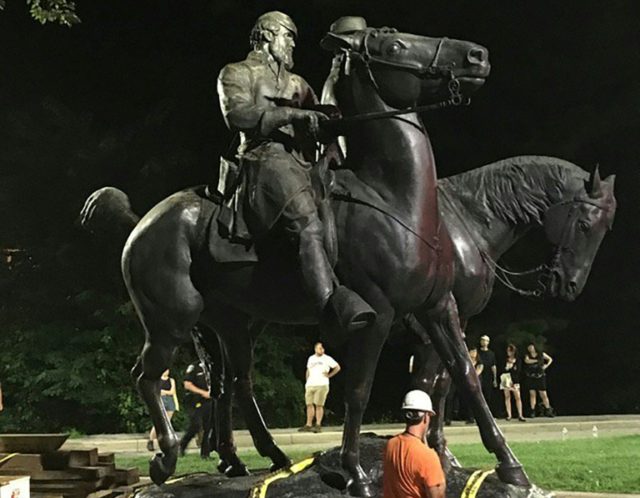If the simulacrums could speak, they would say: “Leave me be—I’m a Democrat, too!”
Democrats feverishly wage war on symbols, statuary, signage, and other inanimate objects unable to defend themselves. Most of the no-longer standing statues lived as Democrats in good standing. From Robespierre to Trotsky, the revolution always devours its own.
Who’s next? If the protestors, which include not only the onsite mob but their distant cheerleaders holding elected office, follow their own logic then their sledgehammers, dynamite, and redacting markers soon come for some of the Democratic Party’s biggest names of the twentieth century.
Woodrow Wilson defended the Ku Klux Klan in his scholarly writings, screened Birth of a Nation at the White House, and bizarrely required pictures in applications for federal jobs. “I would say that I do approve of the segregation that is being attempted in several of the departments,” he candidly admitted. When African Americans complained of segregation in the military during the Great War, Wilson insisted that “segregation is not a humiliation but a benefit.”
Franklin Roosevelt nominated Hugo Black to the U.S. Supreme Court in 1937. While the Alabaman’s membership in the Klan became the subject of rumor during his career in the Senate, the public did not receive conclusive proof until a journalist presented his resignation letter, signed with an “I.T.S.U.B.” (In the Sacred, Unfailing Bond) complimentary close, shortly after his confirmation. When reporters asked the president about the wisdom of not utilizing the Justice Department to scrutinize the background of his first Supreme Court nominee, Roosevelt responded that “a man’s private life is supposed to be his private life,” i.e., what one does between the sheets remains one’s own business.
Before serving as the Senate leader for Democrats during the Carter and Reagan presidencies, Robert Byrd served as an Exalted Cyclops in the Ku Klux Klan. In a fawning 1945 letter to Mississippi Senator Theodore Bilbo, Byrd confessed: “Rather I should die a thousand times, and see Old Glory trampled in the dirt never to rise again, than to see this beloved land of ours become degraded by race mongrels, a throwback to the blackest specimen from the wilds.” Jimmy Carter regarded Byrd as his most important advisor, Bill Clinton dismissed the West Virginia senator’s “fleeting association” with the KKK because his redemptive work in politics, and Barack Obama noted that America’s longest serving senator “came to regret” his leadership position in a hate group.
Woodrow Wilson’s name appears on a bridge over the Potomac, a federally-funded think tank, and a public policy school at Princeton. Hugo Black’s face graced a postage stamp and his name appears on a federal courthouse. More than three dozen publicly-funded entities derive their names from Robert Byrd, a generous philanthropist with other people’s money.
The vandals use the distance of time or geography as a Jedi Mind Trick to obscure that the inanimate objects receiving their rage almost uniformly shared their party affiliation. Targeting Woodrow Wilson or Franklin Roosevelt makes it harder for the cognitive dissonance to pass the laugh test, which explains why, for the most part, the names of these Democratic Party icons remain uncontested as worthy of honor and unmolested on buildings, stamps, bridges, currency, and much else.
The Talibanesque destruction of public art and local memorials wages war on history. The convenient exclusion of certain untouchable figures plays as part of that war on history, too.

COMMENTS
Please let us know if you're having issues with commenting.